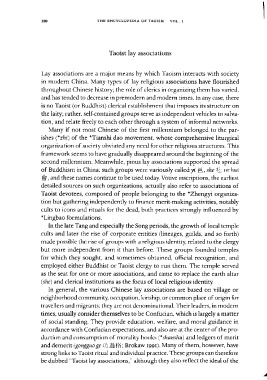Page 150 - The Encyclopedia of Taoism v1_A-L
P. 150
110 THE ENCYCLOPEDIA OF TAOISM VOL. I
Taoist lay associations
Lay associations are a major means by which Taoism interacts with society
in modern China. Many types of lay religious associations have flourished
throughout Chinese history; the role of clerics in organizing them has varied,
and has tended to decrease in premodern and modern times. In any case, there
is no Taoist (or Buddhist) clerical establishment that imposes its structure on
the laity; rather, self-contained groups serve as independent vehicles to salva-
tion, and relate freely to each other through a system of informal networks.
Many if not most Chinese of the first millennium belonged to the par-
ishes (*zhi) of the *Tianshi dao movement, whose comprehensive liturgical
organization of society obviated any need for other religious structures. This
framework seems to have gradually disappeared around the beginning of the
second millennium. Meanwhile, pious lay associations supported the spread
of Buddhism in China; such groups were variously called yi 13, she H or hui
~ , and these names continue to be used today. Votive inscriptions, the earliest
detailed sources on such organizations, actually also refer to associations of
Taoist devotees, composed of people belonging to the *Zhengyi organiza-
tion but gathering independently to finance merit-making activities, notably
cults to icons and rituals for the dead, both practices strongly influenced by
*Lingbao formulations.
In the late Tang and especially the Song periods, the growth of local temple
cults and later the rise of corporate entities (lineages, guilds, and so forth)
made possible the rise of groups with a religious identity, related to the clergy
but more independent from it than before. These groups founded temples
for which they sought, and sometimes obtained, official recognition, and
employed either Buddhist or Taoist clergy to run them. The temple served
as the seat for one or more associations, and came to replace the earth altar
(she) and clerical institutions as the focus of local religious identity.
In general, the various Chinese lay associations are based on village or
neighborhood community, occupation, kinship, or common place of origin for
travellers and migrants; they are not denominational. Their leaders, in modern
times, usually consider themselves to be Confucian, which is largely a matter
of social standing. They provide education, welfare, and moral guidance in
accordance with Confucian expectations, and also are at the center of the pro-
duction and consumption of morality books (*shanshu) and ledgers of merit
and demerit (gongguo ge J}J;@. Ht; Brokaw I99I). Many of them, however, have
strong links to Taoist ritual and individual practice. These groups can therefore
be dubbed "Taoist lay associations," although they also reflect the ideal of the

